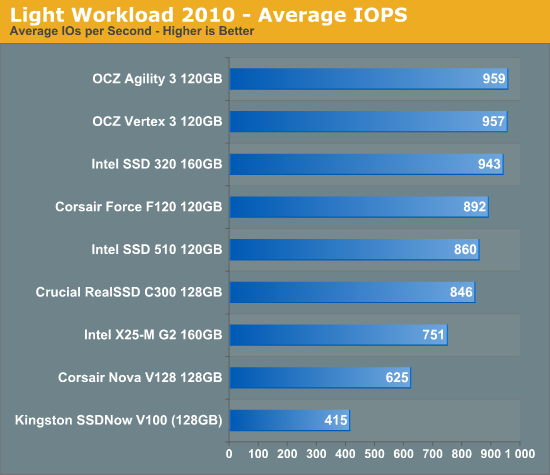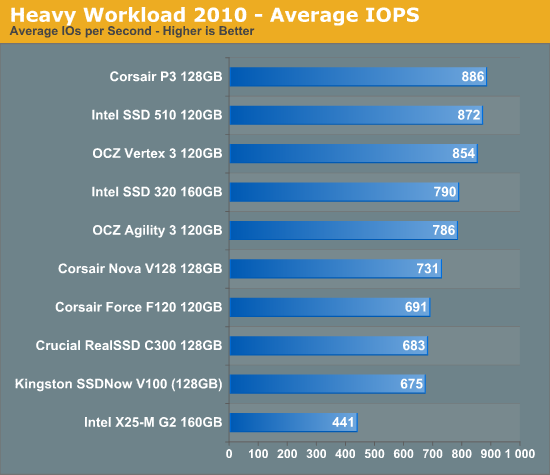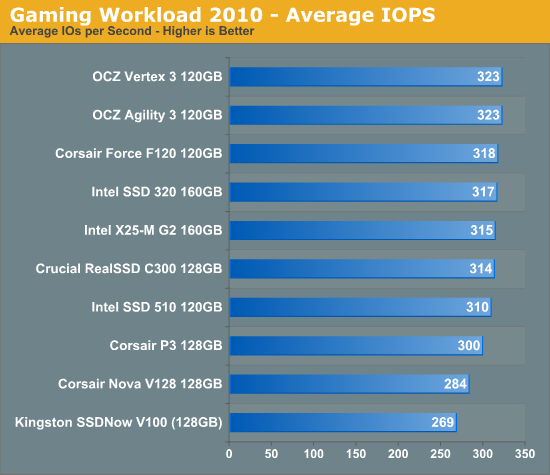The 2011 Mid-Range SSD Roundup: 120GB Agility 3, Intel 510 and More Compared
by Anand Lal Shimpi on June 7, 2011 12:52 PM ESTAnandTech Storage Bench 2010
To keep things consistent we've also included our older Storage Bench. Note that the old storage test system doesn't have a SATA 6Gbps controller, so we only have one result for the 6Gbps drives.
The first in our benchmark suite is a light/typical usage case. The Windows 7 system is loaded with Firefox, Office 2007 and Adobe Reader among other applications. With Firefox we browse web pages like Facebook, AnandTech, Digg and other sites. Outlook is also running and we use it to check emails, create and send a message with a PDF attachment. Adobe Reader is used to view some PDFs. Excel 2007 is used to create a spreadsheet, graphs and save the document. The same goes for Word 2007. We open and step through a presentation in PowerPoint 2007 received as an email attachment before saving it to the desktop. Finally we watch a bit of a Firefly episode in Windows Media Player 11.
There’s some level of multitasking going on here but it’s not unreasonable by any means. Generally the application tasks proceed linearly, with the exception of things like web browsing which may happen in between one of the other tasks.
The recording is played back on all of our drives here today. Remember that we’re isolating disk performance, all we’re doing is playing back every single disk access that happened in that ~5 minute period of usage. The light workload is composed of 37,501 reads and 20,268 writes. Over 30% of the IOs are 4KB, 11% are 16KB, 22% are 32KB and approximately 13% are 64KB in size. Less than 30% of the operations are absolutely sequential in nature. Average queue depth is 6.09 IOs.
The performance results are reported in average I/O Operations per Second (IOPS):

Our old light workload from 2010 highlights an important point about all of these SSDs. For light usage, in a completely IO bound workload, there's only a 13% difference in performance between the fastest 6Gbps drive and last year's C300. If there's only a 13% difference in this completely IO bound test, the real world difference will surely be nonexistent.
If there’s a light usage case there’s bound to be a heavy one. In this test we have Microsoft Security Essentials running in the background with real time virus scanning enabled. We also perform a quick scan in the middle of the test. Firefox, Outlook, Excel, Word and Powerpoint are all used the same as they were in the light test. We add Photoshop CS4 to the mix, opening a bunch of 12MP images, editing them, then saving them as highly compressed JPGs for web publishing. Windows 7’s picture viewer is used to view a bunch of pictures on the hard drive. We use 7-zip to create and extract .7z archives. Downloading is also prominently featured in our heavy test; we download large files from the Internet during portions of the benchmark, as well as use uTorrent to grab a couple of torrents. Some of the applications in use are installed during the benchmark, Windows updates are also installed. Towards the end of the test we launch World of Warcraft, play for a few minutes, then delete the folder. This test also takes into account all of the disk accesses that happen while the OS is booting.
The benchmark is 22 minutes long and it consists of 128,895 read operations and 72,411 write operations. Roughly 44% of all IOs were sequential. Approximately 30% of all accesses were 4KB in size, 12% were 16KB in size, 14% were 32KB and 20% were 64KB. Average queue depth was 3.59.

Our heavy workload is really no different in terms of the performance spread. All of the newer drives show very similar performance.
The gaming workload is made up of 75,206 read operations and only 4,592 write operations. Only 20% of the accesses are 4KB in size, nearly 40% are 64KB and 20% are 32KB. A whopping 69% of the IOs are sequential, meaning this is predominantly a sequential read benchmark. The average queue depth is 7.76 IOs.











68 Comments
View All Comments
Oxford Guy - Thursday, June 9, 2011 - link
And so the 240 GB Vertex 2 would be nice to see in a review -- for perspective.jjj - Tuesday, June 7, 2011 - link
without the M4 and the MAX IOPS the comparisson is pointelss since those 2 models are the most interesting on the market atm at 120GB.dcuccia1 - Tuesday, June 7, 2011 - link
This is fantastic, thanks for the roundup. I'd love to see the same analysis at the low-end. When I build my or mom a PC with a 64GB SSD drive, I have no firm grasp on which generation of drives have the best value for a mom-style workload (word processing, music, videos, etc).SmCaudata - Tuesday, June 7, 2011 - link
Anything you can find.I have a first gen vertex 60gb that I got for $89 or something on sale before the Vertex2 drives came out. Even coming from a 1gb samsung F3 it was night and day. Outlook opens instantly and that is by far the most data intensive of the general use/productivity programs. I'm guessing music and videos will be on a separate drive anyway due to size and they play back at a fixed speed regardless so a spindle drive is just as fast for them.
So again, in summary... anything from a reputable vendor is likely going to be night and day. If you can pick up an Intel for reliability that would be a good way to go. There are some firmware issues with the c300 drives that have the potential to make them really slow, but I'm not familiar with them so I cannot speak to the specifics.
dcuccia - Wednesday, June 8, 2011 - link
Thanks, good points all around. Still, would be cool to see which drives gave a good bang for the buck for light workload systems. But you're right, at the right price it would be hard to go wrong with an old Vertex or Intel.Mr Perfect - Tuesday, June 7, 2011 - link
I'm also interested in how 64GB drives would scale, but only because they are the largest drives Intel will let you use for SSD caching. That would be completely different benchmark runs though...tecsi - Friday, July 8, 2011 - link
Yes, I have exactly the same question. What about boot/app desktop SSDs in the 40-100GB range (<$100)?Quizzical - Tuesday, June 7, 2011 - link
Are you sure that the Crucial RealSSD C300 only has 111.8 GB of usable capacity? Last July, you said that exactly the same SSD had 119.2 GB. I have the "64 GB" version of the same drive, and Windows reads it as 59.5 GB of usable capacity, so I'd expect the "128 GB" version to be around 119 GB.I don't have one, but Legit Reviews also shows the Corsair Performance 3 as having 119 GB of usable capacity, not 111.8 GB. In the past, Corsair has been inclined to do the usual hard drive manufacturer shenanigans of claiming 1 billion bytes as 1 GB, but not going beyond that and listing the total NAND flash. See the F115, which gives you about 115 billion bytes of capacity, but isn't marketed as a 128 GB drive, in spite of 128 GB of NAND flash.
Anand Lal Shimpi - Tuesday, June 7, 2011 - link
You're very correct, fixed :)Tommyv2 - Tuesday, June 7, 2011 - link
Should've waiting until you had the 120GB m4 and the 120GB Max IOPs units for review, especially with some other sites showing that the 120GB m4 actually beats out the 240GB unit in some benchmarks! Those are the two I'm most interested in, and yet there are too few reviews out there for them...